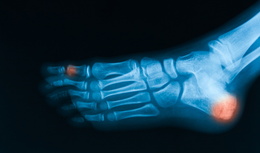Bone spurs are also known as osteophytes, and refer to the abnormal growth of any bone in your body. In this Buzzle article, we tell you more about bone spurs, and the effective treatment measures of the same.

A bone spur is an extra growth of bone that occurs at the edges of the bones. These bony projections are not painful in themselves. However, they rub against the nerves in that particular area and cause pain. They usually develop at the joints, and in the areas where the ligament and tendons meet the bone. Apart from these areas, the spine can also develop a bone spur. The common body parts in which it develops are the hands, feet, hips, knees, and spine. Many times, it shows no symptoms, and thus, is not detected for years.
Treatment
Heel bone spurs are located at the bottom of the heels, and are hook-shaped, small, abnormal bone growths outside the bone. The plantar fascia ligaments are attached to the heel bones, and this is where the bone spur usually grows, but not always. It can grow inside the heel bone also, and does not cause any pain. However, the heel bones irritate the soft tissue around the heel, and can cause an inflammation.
Heel bone spur requires immediate treatment. Surgery is not always recommended in this case. The best treatment is to minimize the pull of ligaments that is experienced, and this is where the heel pain originates. Proper footwear and shoes that support the heel are recommended for sports and other daily activities. The tension of the ligaments is supported using insoles. The pressure on the heels are relieved using heel pads and heel cushion. Ice massages can also be an effective treatment option. The massage helps reduce inflammation in the tissue and tendons. Lastly, a night splint can be used to maintain the length of the tight muscles.
Treatments for spurs in the shoulders, wrists, elbows, and spine are somewhat the same as that for the heel. The main treatment recommended for every spur is rest. Rest and only rest can relieve you from the pain. Muscle relaxants and anti-inflammatory medications are recommended to relieve the strain and inflammation. Cortisone injections are given in the affected area. Lastly, when the bone spurs cannot be controlled by non-surgical treatments, they are treated by surgery. The ones that are found in the spine are also usually treated with surgery. These are mainly caused due to arthritis. There are two types of surgeries performed, cheilectomy and arthrodesis.
These were surgical and nonsurgical methods of bone spur treatment. The main thing to do is to remember to take rest, as rest can relieve the throbbing pain.


 A bone spur is an extra growth of bone that occurs at the edges of the bones. These bony projections are not painful in themselves. However, they rub against the nerves in that particular area and cause pain. They usually develop at the joints, and in the areas where the ligament and tendons meet the bone. Apart from these areas, the spine can also develop a bone spur. The common body parts in which it develops are the hands, feet, hips, knees, and spine. Many times, it shows no symptoms, and thus, is not detected for years.
A bone spur is an extra growth of bone that occurs at the edges of the bones. These bony projections are not painful in themselves. However, they rub against the nerves in that particular area and cause pain. They usually develop at the joints, and in the areas where the ligament and tendons meet the bone. Apart from these areas, the spine can also develop a bone spur. The common body parts in which it develops are the hands, feet, hips, knees, and spine. Many times, it shows no symptoms, and thus, is not detected for years.